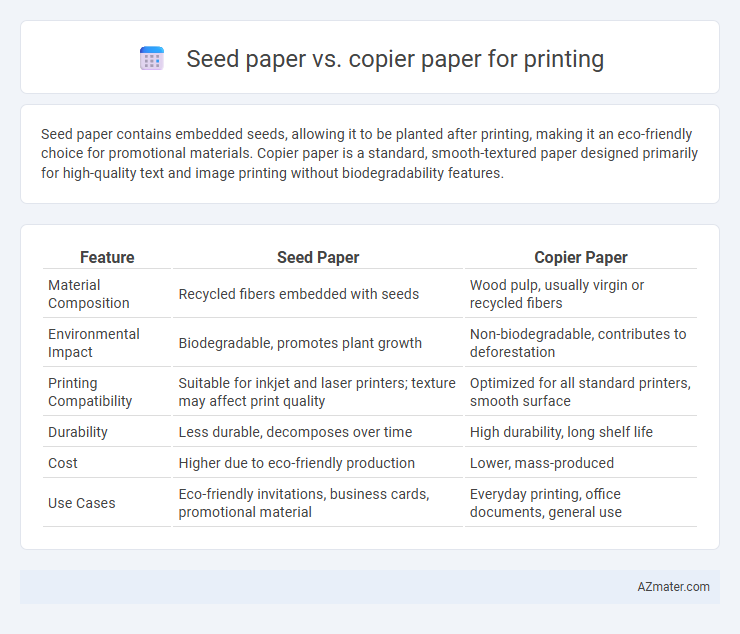Seed paper contains embedded seeds, allowing it to be planted after printing, making it an eco-friendly choice for promotional materials. Copier paper is a standard, smooth-textured paper designed primarily for high-quality text and image printing without biodegradability features.
Table of Comparison
| Feature | Seed Paper | Copier Paper |
|---|---|---|
| Material Composition | Recycled fibers embedded with seeds | Wood pulp, usually virgin or recycled fibers |
| Environmental Impact | Biodegradable, promotes plant growth | Non-biodegradable, contributes to deforestation |
| Printing Compatibility | Suitable for inkjet and laser printers; texture may affect print quality | Optimized for all standard printers, smooth surface |
| Durability | Less durable, decomposes over time | High durability, long shelf life |
| Cost | Higher due to eco-friendly production | Lower, mass-produced |
| Use Cases | Eco-friendly invitations, business cards, promotional material | Everyday printing, office documents, general use |
Introduction to Seed Paper and Copier Paper
Seed paper is an eco-friendly material embedded with plant seeds that can be planted after use, promoting sustainability and reducing waste. Copier paper, typically made from wood pulp, is designed for everyday printing and copying tasks, offering smooth texture and consistent quality for ink absorption. Choosing seed paper supports environmental initiatives, while copier paper emphasizes functionality and cost-efficiency in office settings.
Composition and Materials Used
Seed paper is composed of recycled fibers embedded with organic seeds such as wildflowers or herbs, allowing it to be planted after use. Copier paper primarily consists of bleached wood pulp or recycled fibers, designed for smooth printing performance and durability. The natural, biodegradable elements in seed paper contrast with the chemically treated fibers in copier paper, influencing sustainability and end-of-life disposal.
Environmental Impact Comparison
Seed paper decomposes naturally and enriches soil by sprouting plant seeds, significantly reducing landfill waste and carbon footprint compared to conventional copier paper. Copier paper production involves intensive bleaching, deforestation, and high water consumption, contributing to greater environmental pollution and resource depletion. Choosing seed paper supports sustainable forestry practices and promotes biodiversity, making it a more eco-friendly option for printing needs.
Printing Quality and Compatibility
Seed paper offers a unique texture and thickness that can affect ink absorption and drying time, often resulting in a slightly rustic print quality ideal for artistic or eco-friendly projects. Copier paper is engineered for smooth, consistent ink distribution, providing sharp, clear text and vibrant colors with most printers due to its standardized weight and coating. Compatibility with laser and inkjet printers is generally higher with copier paper, while seed paper may require testing to ensure optimal performance and avoid smudging or jamming.
Cost Analysis: Seed Paper vs Copier Paper
Seed paper typically costs 2 to 3 times more than standard copier paper due to its eco-friendly composition and embedded seeds, which increase production expenses. Copier paper remains the economical choice for high-volume printing needs, with prices averaging around $0.01 per sheet, whereas seed paper can range from $0.03 to $0.05 per sheet. The higher initial investment in seed paper can be offset by its environmental benefits and unique marketing appeal, making it suitable for niche applications despite the cost differential.
Durability and Longevity
Seed paper, embedded with biodegradable materials and plant seeds, offers moderate durability but is primarily designed for short-term use, as it begins to decompose when exposed to moisture. Copier paper, made from highly processed wood pulp, provides superior strength and longevity for everyday printing tasks, maintaining integrity over extended periods without significant deterioration. For documents requiring long-term preservation, copier paper outperforms seed paper in durability and resistance to wear.
Applications and Best Use Cases
Seed paper is ideal for eco-friendly promotional materials, invitations, and business cards that can be planted to grow flowers or herbs, enhancing brand sustainability efforts. Copier paper excels in everyday office printing, documents, and high-volume workflows due to its smooth finish, consistent thickness, and affordability. For applications requiring environmental impact reduction and creative marketing, seed paper is best; for standard document replication and cost-effective printing, copier paper remains the preferred choice.
Disposal and Biodegradability
Seed paper is embedded with biodegradable seeds that naturally decompose in soil, promoting eco-friendly disposal by growing plants after use. Copier paper, primarily made from bleached wood pulp, decomposes slower and often contributes to landfill waste unless properly recycled. Choosing seed paper reduces environmental impact through its organic breakdown and seed germination, offering a sustainable alternative to conventional copier paper disposal.
Market Availability and Accessibility
Seed paper and copier paper differ significantly in market availability and accessibility, with copier paper widely available in various retail and online stores due to its extensive use in offices and homes. Seed paper, embedded with plant seeds for eco-friendly purposes, is less commonly stocked by mainstream suppliers and is more frequently found through specialty eco-conscious brands and niche online marketplaces. The accessibility of seed paper remains limited compared to copier paper, impacting its adoption despite growing interest in sustainable printing materials.
Conclusion: Choosing the Right Paper for Printing
Seed paper promotes sustainability by embedding plant seeds that grow after use, making it ideal for eco-conscious projects, while copier paper offers affordability and smooth print quality suitable for high-volume office printing. Selecting the right paper depends on the intended purpose; seed paper works best for marketing materials or invitations with an environmental message, whereas copier paper is preferred for everyday documents requiring sharp text clarity. Balancing environmental impact with functionality ensures the paper choice aligns with both printing needs and ecological goals.

Infographic: Seed paper vs Copier paper for Printing
 azmater.com
azmater.com